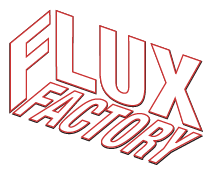Queens Chronicle on Repeat after Me, 2006

Ruminations On Replication: ‘Repeat After Me’ Opens At Flux Factory
by Jennifer Manley, Assistant Editor
Imagine for a moment molecular nanotechnology gone horribly awry: Through an accidental mutation or malicious act, the infinitesimally tiny machines (built to cure human disease, enable space travel and eliminate pollution) learn to self-replicate, systematically consuming all carbon matter and blanketing the planet in a cold, quivering mass of machine.
This is what keeps artist Carla Aspenberg up at night and is partially what inspired “Repeat After Me,” an interdisciplinary art exhibit now on view at the Flux Factory, a nonprofit arts organization and live-work space in Long Island City.
Aspenberg and co-curator Sarah Phillips put together the collective that poses some serious questions about self-replication: What if inanimate ideas, like language, emotions or rainbows could act like a virus? What does the replication of an artist’s identity in a piece of art ultimately mean? What are the consequences of endless repetition?
On the whole, the exhibit is significantly lighter than the end-of-time scenario envisioned by science-fiction aficionados and cynical scientists. The dozen-plus pieces on display in the boxy second-floor exhibit space range from drawings and paintings to sculpture and installation. They deal variably with concepts of self-replication, repetition of form and idea, and asexual reproduction, among others. A few conclusions are offered, but moreover, the show is a thought-provoking exploration on the themes.
Farley Gwazda’s process piece, “Relay,” involves a series of hand-painted tiles mounted in rows. Each row begins with a single, simple image painted in black on a pale tile. Following across the row, the image changes slightly, or vastly, on each subsequent tile, changing into a new image, “Metamorphosis”-style, by the last tile.
The piece was created through a modified version of the game “telephone,” with one participant describing the image to the next, who then sketched it. The replication of the image did not demonstrate entropy, as Gwazda thought it might, but instead revealed magical forms and puzzling patterns. In his role as “Mr. Intelligent Design,” Gwazda steered the evolution of each image through imposing time limits and finally redrawing the participants’ sketches with glaze on the tiles.
Phillips and Aspenberg both have pieces in the show, although they deal with the theme in vastly different ways. Aspenberg’s industrial-material sculpture incorporates cellophane wrap and Ace bandages in a futuristic vision of what a being who didn’t need to reproduce sexually – but still had the organs – might look like.
Phillips’ relatively light piece plays on the theme of “gray goo,” the common term for the apocalyptic takeover of the planet by tiny machines, but with self-replicating rainbows instead of robots.
The reflection, if not replication, of an artist’s identity through the creation of work inevitably arises in several pieces, the most striking of which is a series of latex masks by Ian Montgomery. Casts of his own face are altered with the addition of somewhat disturbing elements and features, then tacked to rough wooden plaques.
Flux Factory’s own Kerry Downey, whose installation is less literal, incorporates hundreds of cup-shaped plaster molds affixed in a swath across one gallery wall like a topographical map of her idea.
The artists in the show hail from all over the country and beyond, with representation from Brooklyn, San Francisco and Europe.
The show is running now through Jan. 28. Gallery hours are Friday through Sunday noon to 6 p.m. or by appointment. Details and directions available at www.fluxfactory.org
